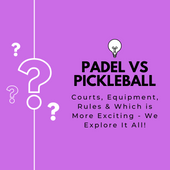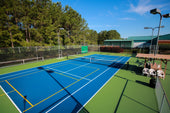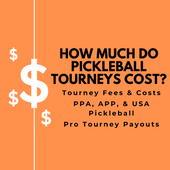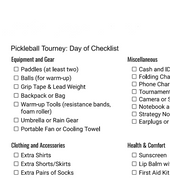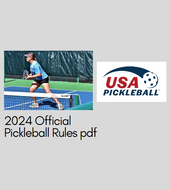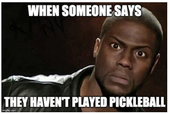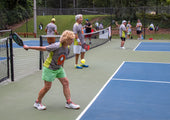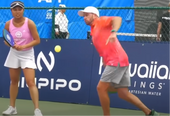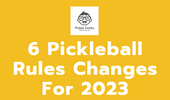Ever feel frustrated by pickleball's "sideout" scoring system?
You can only score a point in pickleball when it’s your (or your team’s) turn to serve. Huh?
There are three parts to the score in doubles......whaaaat?
And what in the heck is a sideout, anyway?
Pickleball's scoring approach may seem confusing at first glance. But don't worry, we're here to help you understand the weirdest scoring system in sports!
After reading this article you’ll be a pickleball scoring pro - ready to explain what 2-4-2 means and knowing which side to serve from when you have an odd numbered score in singles!
How Do You Keep Score In Pickleball - The Basics
Let’s start with the basics of pickleball scoring.
Sideout scoring is one of the few racket (err, paddle) sport scoring methods where a player can only win a point (that is, have a point added to their score) if he/she served to start the rally.
There is another scoring method used by Major league Pickleball called Rally scoring, where points are awarded at the end of each rally regardless of which player served.
However, for now, sideout scoring is the primary scoring system used in sanctioned pickleball tournaments and most recreational games.
How To Call The Score In Pickleball
In singles or doubles pickleball, the player who serves should call the score before each and every serve.
Consistently calling the score reduces mistakes and ensures all players agree on the score before a point is played.
There is a difference in how the score is called in a singles match versus a doubles match, though.
In the case of a doubles game, the score consists of three numbers:
- the first number is the point count of the serving team,
- the second number is the point count of the defending team, and
- the third number is the server number (either a 1 or a 2)
In pickleball doubles, each team member gets at least one chance to serve on their team’s service turn. The player on the right side of the court is #1 to start a serving turn, and the player on the left side of the court is #2.
The player on the right side (#1) always starts a service turn for a team, hence their number being “1”. The player on the left side is always the 2nd server.
On their serve turn, player #1 starts the service sequence on their turn and continues serving until their team loses a rally.
Next, player #2 serves and continues serving until their team loses a rally, at which point there is a sideout and the serve goes over to the opponent.
If team A is serving and has 0 points, team B has 2 points, and team A’s 2nd server is serving, he or she will call the score 0-2-2. We’ll go into this in more detail in a bit :)
In singles pickleball, scoring is much easier. The score is always 2 digits and the serving player should call the score by saying these two numbers. The first number is always the score of the serving player, and the 2nd number is always the score of the serving player.
For example, if the serving player has 2 points and the returning player 6, the serving player should call 2-6 before serving.
How To Keep Score In Pickleball Doubles
Pickleball doubles’ scoring works similarly to singles, but with one crucial (and often confusing) difference: the doubles score also includes the serving player’s number.
Doubles matches have two players on each side, and on their team’s service turn each player gets at least 1 attempt to serve. It can be hard to remember who served when so sideout scoring added this 3rd number (a 1 or 2 indicating the number of the server) to doubles scoring.
To start the service turn, the player on the right side is #1 and the player on the left side is #2. Player #1 on the right side always serves first to start a service turn.
If player #1 is serving and her team leads 4-3, the score is 4-3-1. If that team loses the rally on their service turn, player 2 will serve (note that the players do not alternate sides after a losing rally. So player 2 will serve from the same side he or she was on when player 1 served to start the very last rally).
If player 2’s team wins the next rally, the score is 5-3-2 and player 2 serves again.
Player 2 will continue serving, alternating sides after each rally won, until their team loses a rally. At this point a “sideout” occurs, and the other team will have the opportunity to serve.
Starting Score Of A Pickleball Doubles Game
Unfortunately the starting score of a doubles pickleball game adds 1 more confusing element to the sideout scoring puzzle.
As we mentioned above, the 3 numbers in a pickleball doubles game are the serving team’s score, the returning team’s score, and the serving player’s number. This should mean that the starting score of a doubles game will be 0-0-1, right?
Wrong :). In a doubles game, the team that serves first to start the game will only have 1 server. This is to ensure the serving team doesn’t have too much of an advantage to start the game.
So the very first server of the game will always be the second player of the first team, which makes the starting score 0-0-2.
Pickleball Doubles Scoring Example
Let’s look at an example of how to keep score in a pickleball doubles game.
Assume we have two teams:
- Team A with players Anna (1, right side) and Leigh (2, left side)
- Team B with players Jenny (1, right side) and Jorja (2, left side)
If team A serves first, then Anna will call the score 0-0-2 and serve the ball from the right side of the court to Jenny (also on the opposite right side of the court).
If team A wins a rally, team A will score a point. Leigh and Anna will switch sides, while Jenny and Jorja will keep their positions.
Anna will call out the score 1-0-2 (since team A now has 1 point), then serve again - this time from the left side of the court to Jorja on the left side of the court on the other side of the net.
If team A loses the second rally, there is a sideout and team B will get the serve. All players will maintain their position on the court.
Jenny will call out the score 0-1-1 (because team B’s score of 0 will now be quoted first), followed by team A’s score (1), then the serving player’s number (1).
Let’s say that team B wins the next 2 rallies while Jenny is serving, then they lose the next rally.
Jorja will then take over the serving duties and call the score 2-1-2 because team B now has 2 points, team A still has 1 point, and player 2 (Jorja) is now serving.
For everyone playing very close attention Jorja will be serving from the left side of the court (Jorja and Jenny would have switched sides twice when they won 2 rallies on Jenny’s serve, so Jorja would be back on the left side after the 2 won rallies).
This process will continue until one of the teams gets to 11 points or more (with a lead of at least 2 points).
How To Keep Score In Pickleball Singles
Pickleball singles scoring is easier to track than doubles since there are only two numbers - each player’s points.
As in doubles, players accumulate points by winning rallies on their serves (no points are accumulated winning rallies when the other player serves).
The only tricky part of playing singles and keeping score is knowing which side to serve from. Players serve from the right side if they have 0 or an even number of points, and from the left side if they have an odd number of points.
The above is true even on the first serve on their service turn! This differs from doubles where a team always serves from the right side to start their service turn.
Starting Score Of A Pickleball Singles Game
When a singles game starts, the score is 0-0. The first player to serve should call out the score of 0-0.
Pickleball Singles Scoring Example
Let’s assume we have players Ben and JW squaring off, and Ben serves first.
Ben will call the starting score which at that stage will be 0-0.
Ben will then serve the ball from the right side of the court. Assume Ben wins the rally - he accumulates 1 point and the score is now 1-0. Ben then gets to serve from the left side.
Assume JW wins the next rally, this causes a “sideout” and it is now JW’s serve from the right side. The score is 0-1.
If Ben wins the next rally, another sideout occurs and Ben will serve from the left side with the score 1-0 (Ben serves form the left side because he has an odd number "1" as his score and when the server's score is an odd number he or she always serve from the left side).
This cycle continues until either of the players has at least 11 points and is leading by at least 2 points..
How to Keep Score in Pickleball: FAQs
What Score Do You Play To In Pickleball?
Most official pickleball matches continue until one side scores at least 11 with a lead of at least 2 points over the other.
For example, when a player or a team wins 11 points, the match is over if the other side has 9 points or less.
If one team has a score of 11 points but is not leading by 2, the game will continue until one side leads by at least two points.
The rule of 11, win by 2, is part of the core pickleball rules. However, in some tournaments games may go to 15, but the “win by 2” rule always applies.
Note that some unofficial matches may use a rally scoring system, where you can score regardless of who’s serving at the time. In that scenario, if someone loses a rally, the opponent scores a point, no matter who served.
Do You Get Two Serves In Pickleball Singles?
Players only get one serve turn in pickleball singles matches. Of course, the serving player will continue to serve, alternating sides of the court for each serve, until they lose a rally (but it still counts as only one serve turn).
This is different from pickleball doubles, where each player on a team gets a serving turn (making it at least two serve attempts per team).
How Are Points Scored In Pickleball?
Teams can only score a point when they are serving to start a rally. To score a point while serving, you win the rally by 1) your opponent hitting the ball out of bounds or in the net or 2) you hit a ball your opponent can not return (either they can’t reach it, the ball hits their body, or they hit the ball out of play).
What’s The Difference Between Sideout Scoring And Rally Scoring In Pickleball?
Sideout scoring is the official, USA Pickleball-approved method of scoring. You will see sideout scoring at almost all tournaments and recreational games.
Sideout scoring’s main premise is that a player or team can only score a point if they served to start a rally. If the returning (non-serving) player or team loses a rally, the side that served to start the rally will receive a point.
Neither side will score a point if the returning (non-serving) team wins a rally.
Rally scoring is a more conventional scoring approach where points are awarded on every rally, regardless of the team that served. Forms of rally scoring are used in ping pong, volleyball, and even tennis.
In rally scoring, most games are played to 21, win by 2.
Official pickleball matches don’t use rally scoring yet, but Major League Pickleball has adopted rally scoring for its competitions so it has become a more popular option for pickleball games.
Some feel that rally scoring makes for more action-packed matches since points accumulate quickly and every rally ends in a point awarded to 1 of the 2 sides.
How Is Pickleball Singles Scoring Different From Doubles Scoring?
There are two main differences in scoring pickleball singles and doubles matches:
What Is The Score To Win In Pickleball?
In most tournament and recreational games, the official winning score for a pickleball game is 11 points with a two-point lead. In other words, if a player or team scores 11 points and the other side has nine points or less, the team with 11 points wins.
There are variations of the 11 point score. In the “back” draw of most tournaments, games are played to 15, win by 2. And in rally scoring formats, games are played to 21, also win by 2.
Summary: How to Keep Score in Pickleball
Keeping score in pickleball isn’t as complicated as it seems, but it does take a little bit of practice! You have to remember a few key things like the 3rd number in a pickleball doubles score and where to serve from in singles (based on your even or odd score). After a few games it will become second nature and you can focus fully on hitting your best 3rd shot drops and drives! Happy pickling :)






